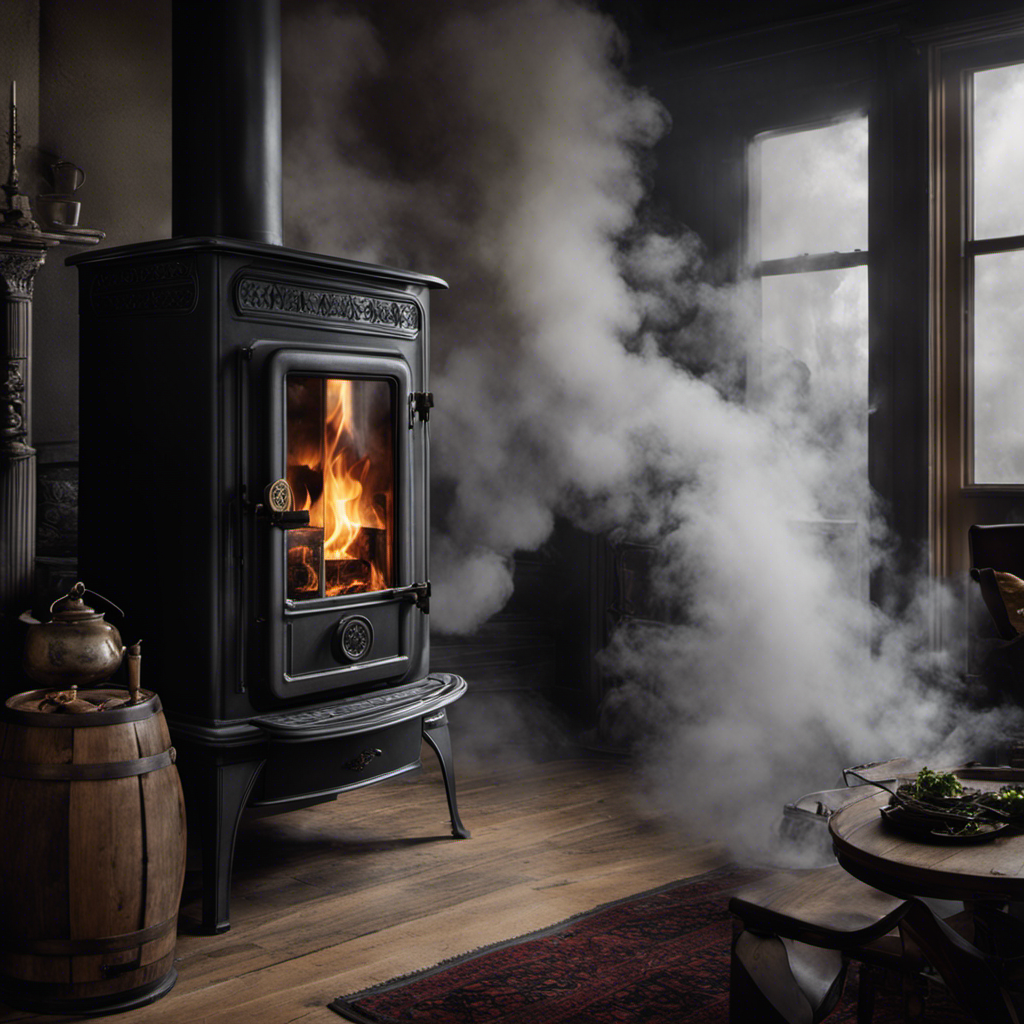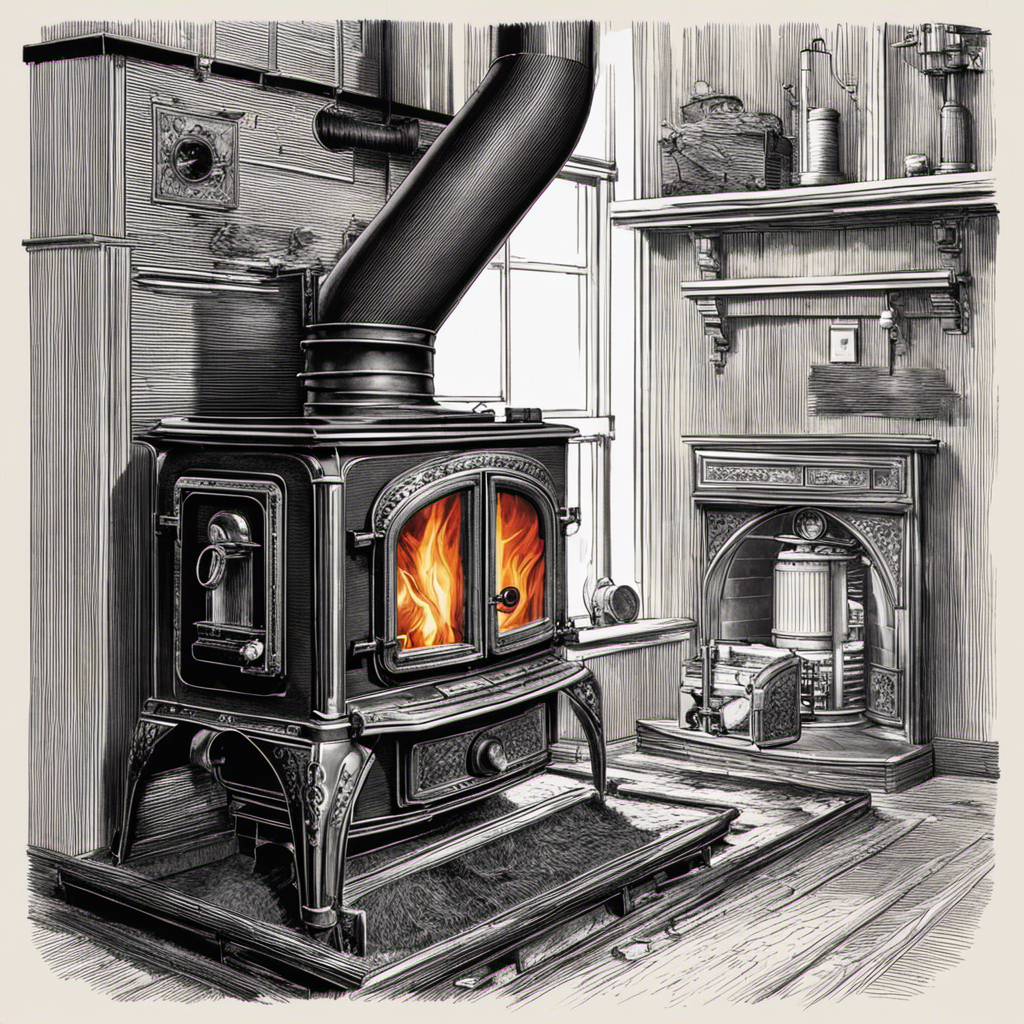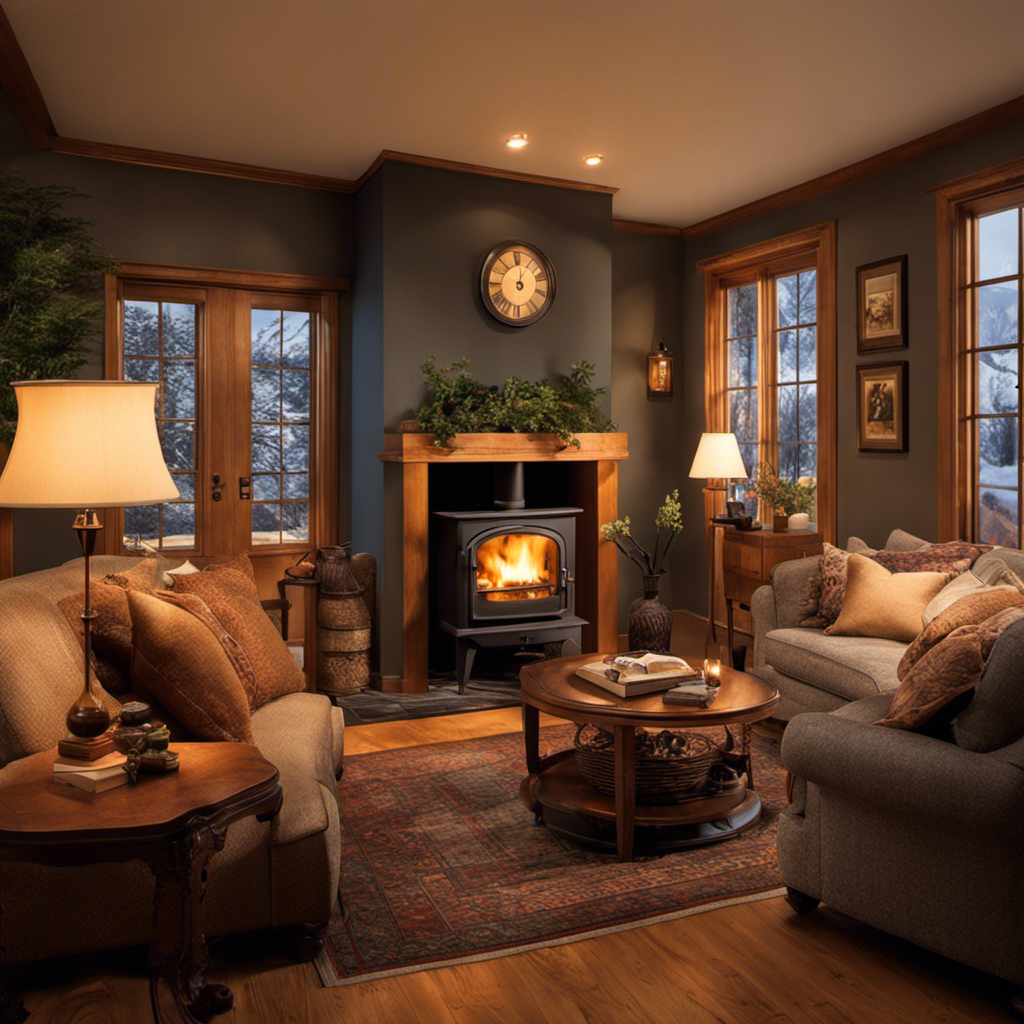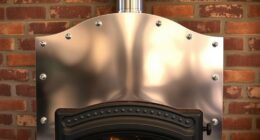Being intimately acquainted with the realm of wood-burning stoves, I have come across many challenges. However, the aggravation of seeing smoke pour out of a wood stove while its door is closed is unparalleled. It’s like trying to relax by a warm fire, only to become surrounded by a cloud of irritation.
However, fear not, for in this article, I’ll delve into the common causes of this issue and provide you with troubleshooting tips and solutions to ensure a smoke-free and enjoyable wood stove experience.
Key Takeaways
- Proper ventilation and regular maintenance of the wood stove and chimney are crucial for preventing smoke from escaping into the room.
- Airflow issues, such as insufficient air supply and air leaks, can contribute to smoke buildup and escape in a wood stove.
- Checking for obstructions in the chimney, using dry and seasoned hardwoods, and choosing the right wood can help reduce smoke emissions.
- Upgrading to a more efficient wood stove with advanced combustion technology and enhanced safety features can improve performance and reduce the risk of accidents.
Common Causes of Wood Stove Smoke With Closed Door
One common cause of wood stove smoke with the door closed is improper ventilation. Proper wood stove ventilation is essential to ensure efficient burning and prevent smoke from escaping into the room. As an experienced wood stove user, I’ve come across this issue many times.
To address this problem, I recommend checking the ventilation system thoroughly. Start by inspecting the chimney for any blockages or buildup that may be restricting the airflow. Additionally, check for leaks in the stovepipe connections and ensure they’re properly sealed. Inadequate sealing can lead to smoke leaking into the room rather than being directed outside.
Regularly maintaining and cleaning the ventilation system will help prevent smoke-related issues and ensure a safe and enjoyable wood stove experience.
Understanding Airflow Issues in Wood Stoves
I can better understand airflow issues in wood stoves by observing how smoke behaves when the door is shut. When it comes to wood stove installation, proper ventilation is crucial. Here are three key aspects to consider:
-
Adequate Air Supply: Insufficient air supply can lead to a buildup of smoke inside the stove. This can be caused by closed vents or clogged air inlets. Ensuring a proper air supply is essential for efficient combustion and preventing smoke from escaping into your home.
-
Air Leaks: Identifying and fixing air leaks is another important step. Leaks can occur around the stove door, seams, or chimney connections. These leaks disrupt the airflow and can result in smoke escaping into the room. Properly sealing these areas can significantly improve stove performance.
-
Chimney Draft: A weak or inadequate chimney draft can also contribute to smoke issues. Factors like chimney height, diameter, and obstruction can affect the draft. It’s crucial to ensure proper chimney construction and maintenance to maintain a strong draft.
Understanding these airflow issues will help diagnose and fix smoke problems in wood stoves. Now, let’s move on to troubleshooting tips for fixing a smoking wood stove.
Troubleshooting Tips for Fixing a Smoking Wood Stove
When troubleshooting a smoking wood stove, it’s important to check for any obstructions in the chimney. Proper ventilation for wood stoves is crucial in preventing smoke from entering the room when the door is closed. One common cause of smoking is a blocked chimney or flue pipe.
Inspect the chimney for any debris, such as bird nests or creosote buildup, that may be obstructing the airflow. Clearing these obstructions can improve the stove’s performance and reduce smoke emissions.
Additionally, choosing the right wood for your stove is essential. Wet or unseasoned wood can produce excessive smoke, leading to poor combustion. Opt for dry, seasoned hardwoods like oak or maple, which burn more efficiently and produce less smoke.
Upgrading Your Wood Stove for Better Performance
To improve performance, I upgraded my wood stove with a more efficient model. It was a wise decision as the benefits of using a wood stove are numerous. Here are three reasons why upgrading your wood stove can greatly enhance its performance:
-
Increased efficiency: The new wood stove is designed to maximize heat output while minimizing fuel consumption. This means that it burns wood more efficiently, producing more heat with less waste.
-
Better air quality: Modern wood stoves are equipped with advanced combustion technology, which results in cleaner and more efficient burning. This reduces smoke and particulate emissions, improving indoor air quality and reducing environmental impact.
-
Enhanced safety features: The upgraded wood stove comes with improved safety features, such as airtight doors, heat-resistant glass, and automatic shut-off mechanisms. These features ensure that the stove operates safely and reduces the risk of accidents.
Overall, upgrading my wood stove has significantly improved its performance, making it a more effective and efficient heating solution. The installation process was straightforward, and the benefits of using a wood stove are well worth the investment.
Maintaining and Cleaning Your Wood Stove to Prevent Smoke
Cleaning and maintaining my wood stove regularly is essential for preventing smoke and ensuring optimal performance.
As an experienced wood stove owner, I know that smoke buildup can be a common problem if proper maintenance is neglected. To prevent this issue, I make sure to clean the stove and chimney at least once a year.
This includes removing any ash, soot, or creosote that has accumulated. I also check the door gasket regularly to ensure a tight seal, as a loose seal can lead to smoke leakage. Additionally, I inspect the chimney for any blockages or obstructions that could hinder proper airflow.
Frequently Asked Questions
Can Using Wet or Unseasoned Wood Cause a Wood Stove to Smoke When the Door Is Closed?
Using wet or unseasoned wood in a wood stove can cause it to smoke when the door is closed. The moisture in the wood creates more smoke, which can’t fully combust, leading to smoky conditions.
What Are Some Common Signs of a Poorly Functioning Chimney That Could Cause Smoke to Fill the Room When the Wood Stove Door Is Closed?
When the wood stove door is closed, signs of a poorly functioning chimney, like smoke filling the room, indicate potential blockage. Insufficient insulation can also impact the stove’s performance, leading to smoke.
Are There Any Specific Weather Conditions That Can Contribute to a Wood Stove Smoking When the Door Is Closed?
Specific weather conditions, such as high humidity, can contribute to a wood stove smoking when the door is closed. This can be caused by a lack of proper ventilation and air flow, leading to smoke buildup in the room.
Can a Blocked or Obstructed Flue Pipe Lead to a Wood Stove Smoking When the Door Is Closed?
Yes, a blocked or obstructed flue pipe can lead to a wood stove smoking when the door is closed. It prevents proper ventilation and causes smoke to back up. Additionally, burning wet wood can also contribute to smoke production.
Are There Any Specific Adjustments or Modifications That Can Be Made to the Wood Stove’s Air Intake to Prevent Smoke When the Door Is Closed?
Adjusting the air intake or modifying the wood stove can help prevent smoke when the door is closed. By ensuring proper airflow and addressing any obstructions or blockages in the flue pipe, smoke can be minimized and the stove can function efficiently.
Conclusion
After exploring the common causes of a wood stove smoking when the door is closed, understanding airflow issues, troubleshooting tips, and upgrading options, it’s clear that maintaining and cleaning your wood stove is crucial in preventing smoke.
By taking proper care of your stove, you can ensure better performance and a smoke-free environment.
However, there’s still one more secret to reveal, a hidden solution that will revolutionize the way you use your wood stove.
Stay tuned for our next article to uncover this game-changing revelation.
Growing up surrounded by the vast beauty of nature, Sierra was always drawn to the call of the wild. While others sought the comfort of the familiar, she ventured out, embracing the unpredictable and finding stories in the heartbeat of nature.
At the epicenter of every remarkable venture lies a dynamic team—a fusion of diverse talents, visions, and passions. The essence of Best Small Wood Stoves is crafted and refined by such a trio: Sierra, Logan, and Terra. Their collective expertise has transformed the platform into a leading authority on small wood stoves, radiating warmth and knowledge in equal measure.











